Leadership and Change: Stakeholders, Approaches, and Strategies Report
VerifiedAdded on 2023/01/11
|7
|1253
|86
Report
AI Summary
This report examines leadership and change management within the context of Captify's proposed expansion. It begins with an introduction defining leadership and its influence. The main body analyzes stakeholders using a power-interest matrix, assessing their influence on the organization. It then explores changing leadership approaches, including coaching, supporting, directive, and delegating styles, considering their evolution based on employee competence and motivation. The report further investigates the impact of leadership on organizational culture, emphasizing the importance of people-oriented approaches. Finally, it discusses effective communication strategies for managing organizational changes, such as effective content, active listening, and empathy. The conclusion summarizes the key findings, highlighting the importance of stakeholder analysis, leadership approaches, and communication strategies in the context of organizational change and expansion. The report references several academic sources to support its analysis.
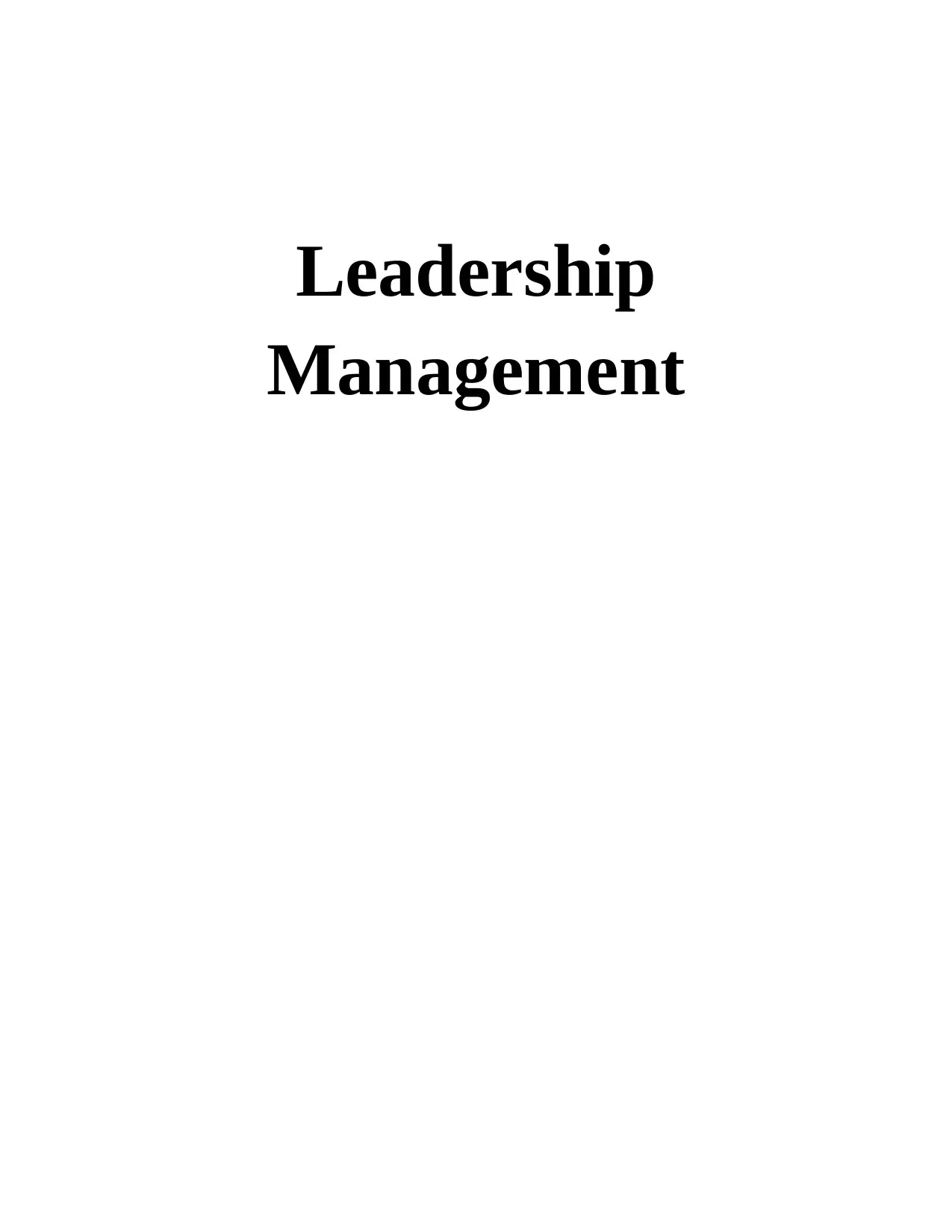
Leadership
Management
Management
Paraphrase This Document
Need a fresh take? Get an instant paraphrase of this document with our AI Paraphraser
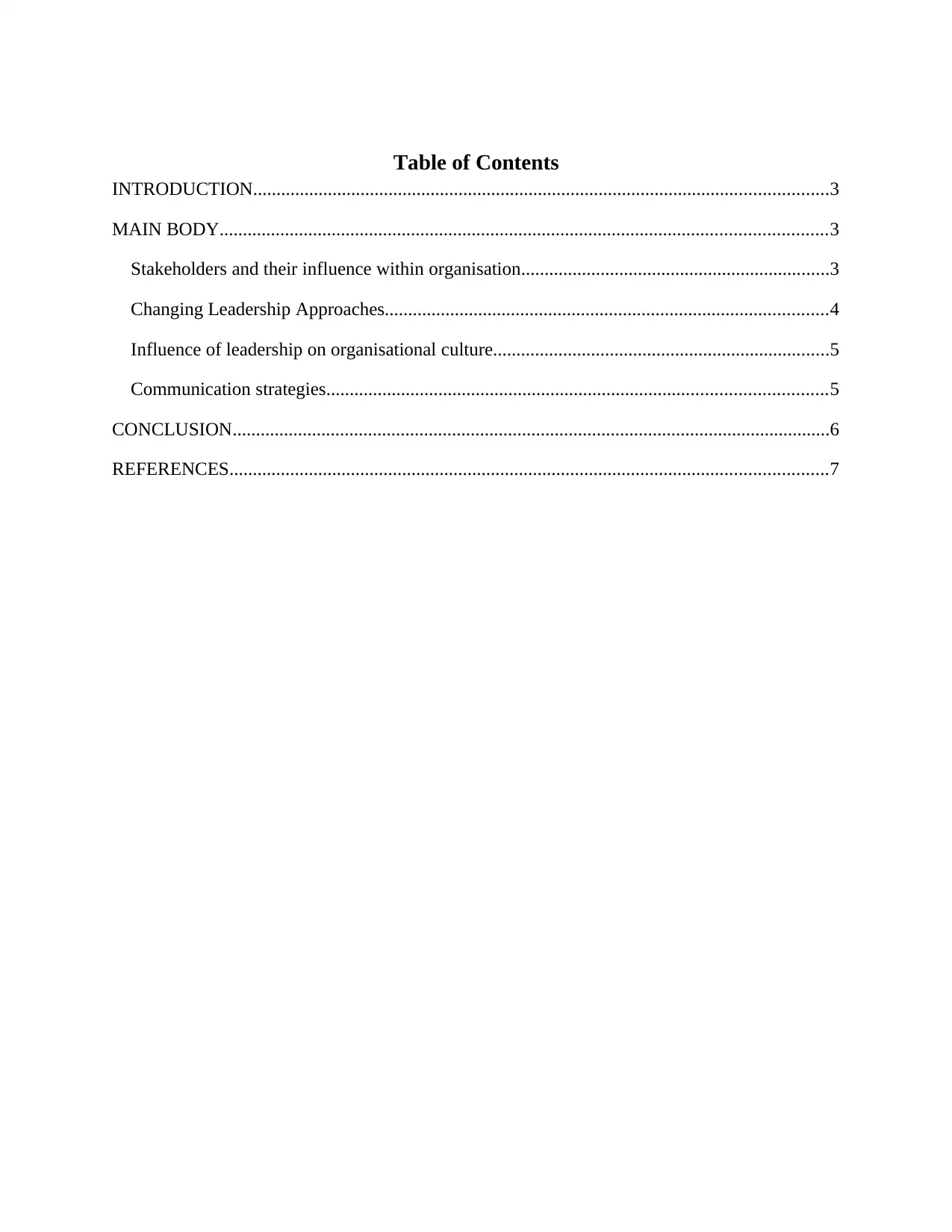
Table of Contents
INTRODUCTION...........................................................................................................................3
MAIN BODY..................................................................................................................................3
Stakeholders and their influence within organisation..................................................................3
Changing Leadership Approaches...............................................................................................4
Influence of leadership on organisational culture........................................................................5
Communication strategies...........................................................................................................5
CONCLUSION................................................................................................................................6
REFERENCES................................................................................................................................7
INTRODUCTION...........................................................................................................................3
MAIN BODY..................................................................................................................................3
Stakeholders and their influence within organisation..................................................................3
Changing Leadership Approaches...............................................................................................4
Influence of leadership on organisational culture........................................................................5
Communication strategies...........................................................................................................5
CONCLUSION................................................................................................................................6
REFERENCES................................................................................................................................7
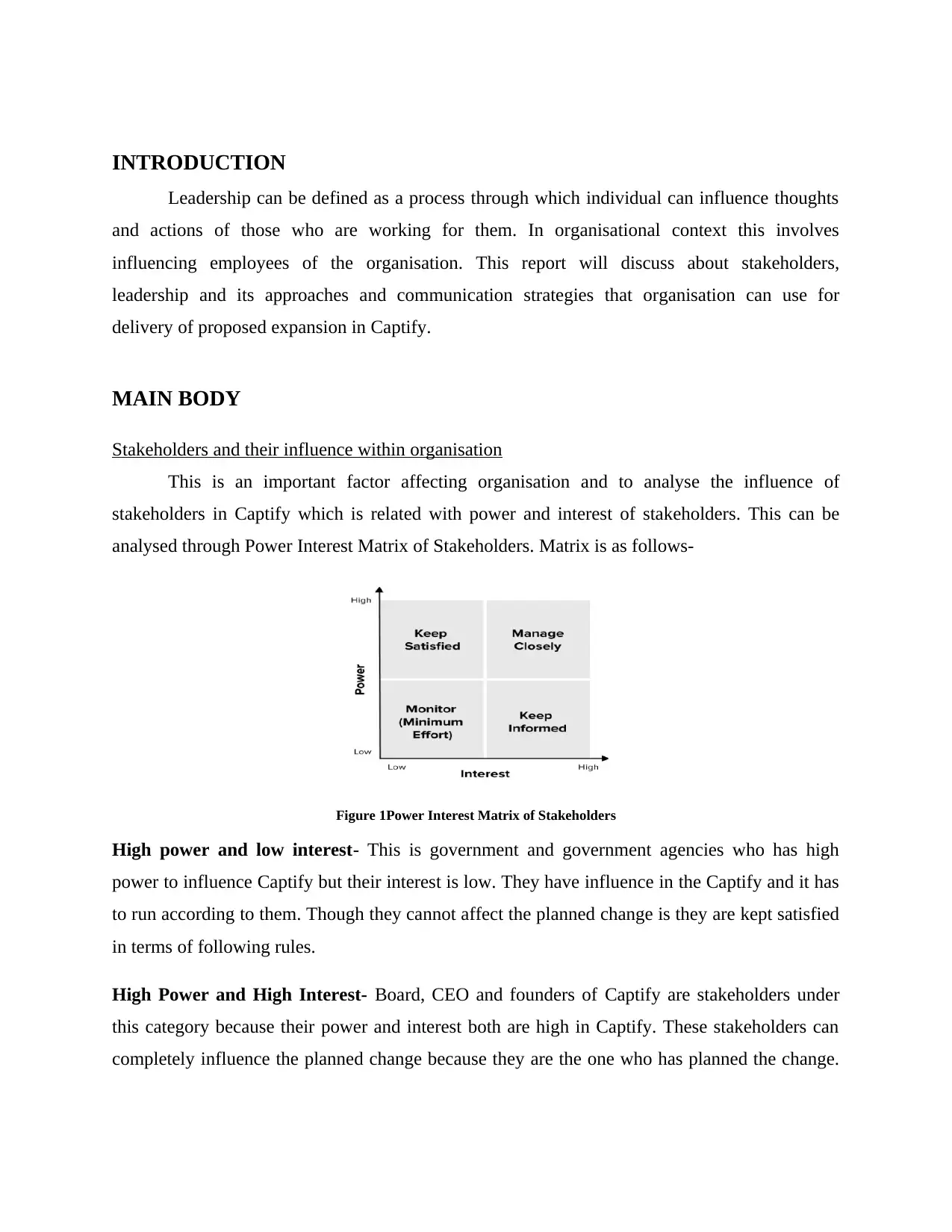
INTRODUCTION
Leadership can be defined as a process through which individual can influence thoughts
and actions of those who are working for them. In organisational context this involves
influencing employees of the organisation. This report will discuss about stakeholders,
leadership and its approaches and communication strategies that organisation can use for
delivery of proposed expansion in Captify.
MAIN BODY
Stakeholders and their influence within organisation
This is an important factor affecting organisation and to analyse the influence of
stakeholders in Captify which is related with power and interest of stakeholders. This can be
analysed through Power Interest Matrix of Stakeholders. Matrix is as follows-
Figure 1Power Interest Matrix of Stakeholders
High power and low interest- This is government and government agencies who has high
power to influence Captify but their interest is low. They have influence in the Captify and it has
to run according to them. Though they cannot affect the planned change is they are kept satisfied
in terms of following rules.
High Power and High Interest- Board, CEO and founders of Captify are stakeholders under
this category because their power and interest both are high in Captify. These stakeholders can
completely influence the planned change because they are the one who has planned the change.
Leadership can be defined as a process through which individual can influence thoughts
and actions of those who are working for them. In organisational context this involves
influencing employees of the organisation. This report will discuss about stakeholders,
leadership and its approaches and communication strategies that organisation can use for
delivery of proposed expansion in Captify.
MAIN BODY
Stakeholders and their influence within organisation
This is an important factor affecting organisation and to analyse the influence of
stakeholders in Captify which is related with power and interest of stakeholders. This can be
analysed through Power Interest Matrix of Stakeholders. Matrix is as follows-
Figure 1Power Interest Matrix of Stakeholders
High power and low interest- This is government and government agencies who has high
power to influence Captify but their interest is low. They have influence in the Captify and it has
to run according to them. Though they cannot affect the planned change is they are kept satisfied
in terms of following rules.
High Power and High Interest- Board, CEO and founders of Captify are stakeholders under
this category because their power and interest both are high in Captify. These stakeholders can
completely influence the planned change because they are the one who has planned the change.
⊘ This is a preview!⊘
Do you want full access?
Subscribe today to unlock all pages.

Trusted by 1+ million students worldwide
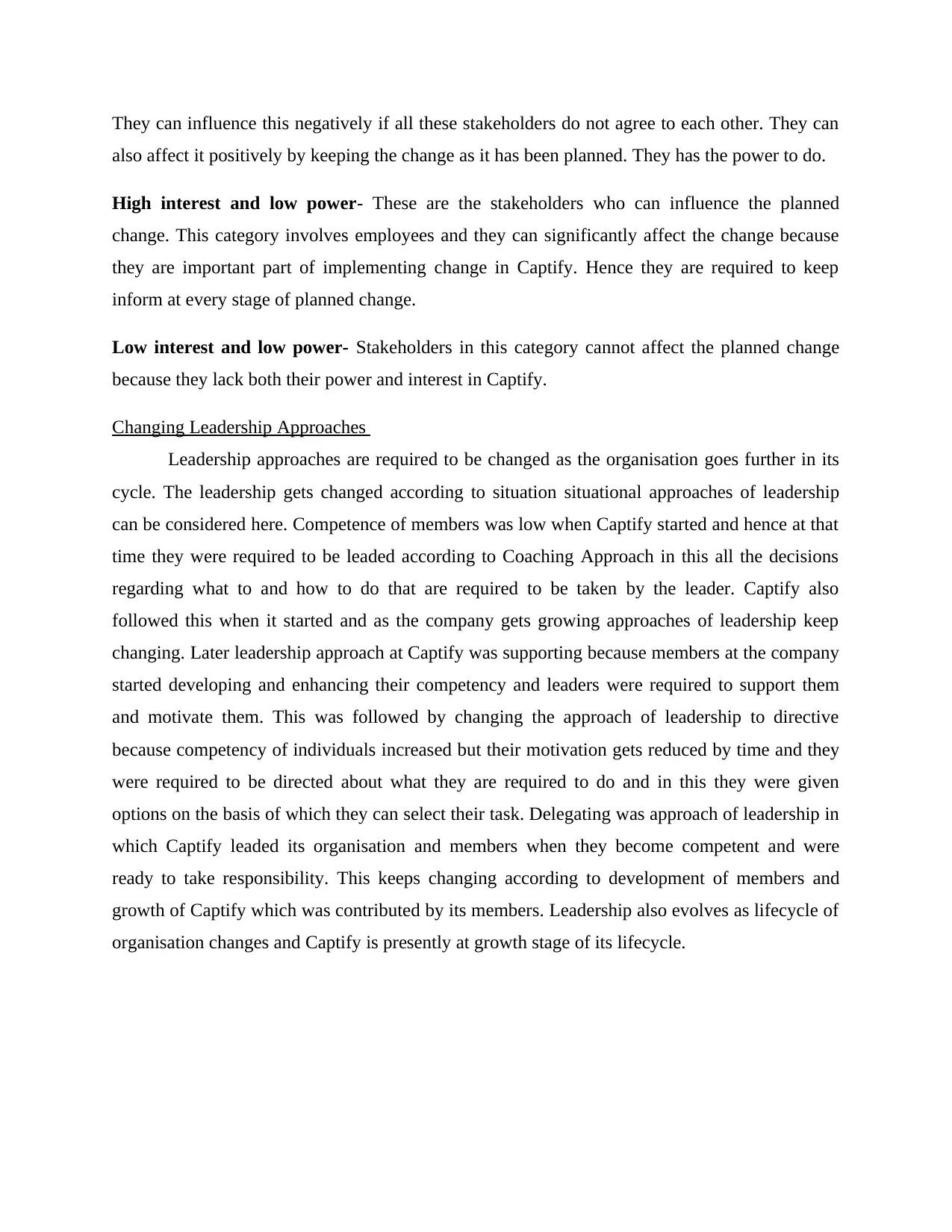
They can influence this negatively if all these stakeholders do not agree to each other. They can
also affect it positively by keeping the change as it has been planned. They has the power to do.
High interest and low power- These are the stakeholders who can influence the planned
change. This category involves employees and they can significantly affect the change because
they are important part of implementing change in Captify. Hence they are required to keep
inform at every stage of planned change.
Low interest and low power- Stakeholders in this category cannot affect the planned change
because they lack both their power and interest in Captify.
Changing Leadership Approaches
Leadership approaches are required to be changed as the organisation goes further in its
cycle. The leadership gets changed according to situation situational approaches of leadership
can be considered here. Competence of members was low when Captify started and hence at that
time they were required to be leaded according to Coaching Approach in this all the decisions
regarding what to and how to do that are required to be taken by the leader. Captify also
followed this when it started and as the company gets growing approaches of leadership keep
changing. Later leadership approach at Captify was supporting because members at the company
started developing and enhancing their competency and leaders were required to support them
and motivate them. This was followed by changing the approach of leadership to directive
because competency of individuals increased but their motivation gets reduced by time and they
were required to be directed about what they are required to do and in this they were given
options on the basis of which they can select their task. Delegating was approach of leadership in
which Captify leaded its organisation and members when they become competent and were
ready to take responsibility. This keeps changing according to development of members and
growth of Captify which was contributed by its members. Leadership also evolves as lifecycle of
organisation changes and Captify is presently at growth stage of its lifecycle.
also affect it positively by keeping the change as it has been planned. They has the power to do.
High interest and low power- These are the stakeholders who can influence the planned
change. This category involves employees and they can significantly affect the change because
they are important part of implementing change in Captify. Hence they are required to keep
inform at every stage of planned change.
Low interest and low power- Stakeholders in this category cannot affect the planned change
because they lack both their power and interest in Captify.
Changing Leadership Approaches
Leadership approaches are required to be changed as the organisation goes further in its
cycle. The leadership gets changed according to situation situational approaches of leadership
can be considered here. Competence of members was low when Captify started and hence at that
time they were required to be leaded according to Coaching Approach in this all the decisions
regarding what to and how to do that are required to be taken by the leader. Captify also
followed this when it started and as the company gets growing approaches of leadership keep
changing. Later leadership approach at Captify was supporting because members at the company
started developing and enhancing their competency and leaders were required to support them
and motivate them. This was followed by changing the approach of leadership to directive
because competency of individuals increased but their motivation gets reduced by time and they
were required to be directed about what they are required to do and in this they were given
options on the basis of which they can select their task. Delegating was approach of leadership in
which Captify leaded its organisation and members when they become competent and were
ready to take responsibility. This keeps changing according to development of members and
growth of Captify which was contributed by its members. Leadership also evolves as lifecycle of
organisation changes and Captify is presently at growth stage of its lifecycle.
Paraphrase This Document
Need a fresh take? Get an instant paraphrase of this document with our AI Paraphraser
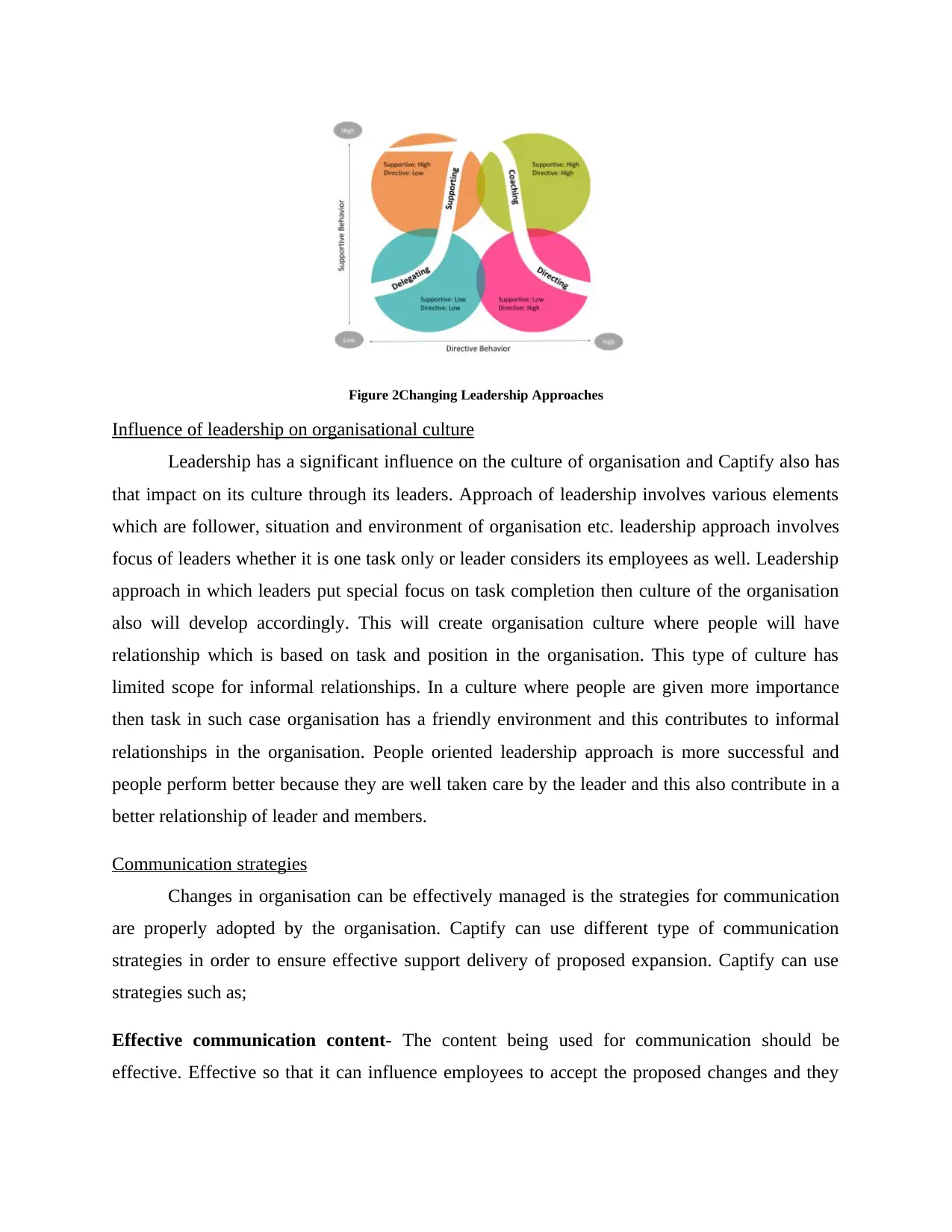
Figure 2Changing Leadership Approaches
Influence of leadership on organisational culture
Leadership has a significant influence on the culture of organisation and Captify also has
that impact on its culture through its leaders. Approach of leadership involves various elements
which are follower, situation and environment of organisation etc. leadership approach involves
focus of leaders whether it is one task only or leader considers its employees as well. Leadership
approach in which leaders put special focus on task completion then culture of the organisation
also will develop accordingly. This will create organisation culture where people will have
relationship which is based on task and position in the organisation. This type of culture has
limited scope for informal relationships. In a culture where people are given more importance
then task in such case organisation has a friendly environment and this contributes to informal
relationships in the organisation. People oriented leadership approach is more successful and
people perform better because they are well taken care by the leader and this also contribute in a
better relationship of leader and members.
Communication strategies
Changes in organisation can be effectively managed is the strategies for communication
are properly adopted by the organisation. Captify can use different type of communication
strategies in order to ensure effective support delivery of proposed expansion. Captify can use
strategies such as;
Effective communication content- The content being used for communication should be
effective. Effective so that it can influence employees to accept the proposed changes and they
Influence of leadership on organisational culture
Leadership has a significant influence on the culture of organisation and Captify also has
that impact on its culture through its leaders. Approach of leadership involves various elements
which are follower, situation and environment of organisation etc. leadership approach involves
focus of leaders whether it is one task only or leader considers its employees as well. Leadership
approach in which leaders put special focus on task completion then culture of the organisation
also will develop accordingly. This will create organisation culture where people will have
relationship which is based on task and position in the organisation. This type of culture has
limited scope for informal relationships. In a culture where people are given more importance
then task in such case organisation has a friendly environment and this contributes to informal
relationships in the organisation. People oriented leadership approach is more successful and
people perform better because they are well taken care by the leader and this also contribute in a
better relationship of leader and members.
Communication strategies
Changes in organisation can be effectively managed is the strategies for communication
are properly adopted by the organisation. Captify can use different type of communication
strategies in order to ensure effective support delivery of proposed expansion. Captify can use
strategies such as;
Effective communication content- The content being used for communication should be
effective. Effective so that it can influence employees to accept the proposed changes and they
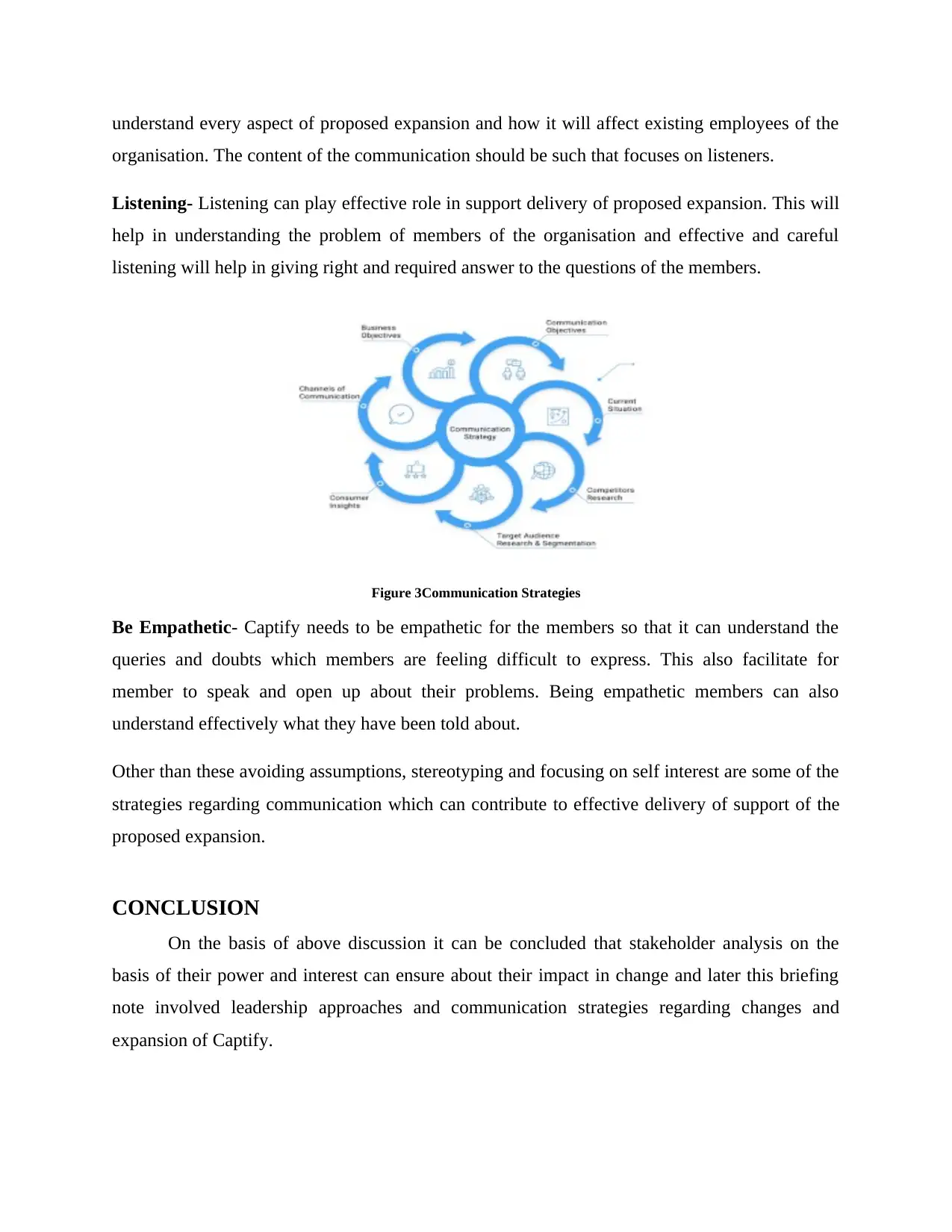
understand every aspect of proposed expansion and how it will affect existing employees of the
organisation. The content of the communication should be such that focuses on listeners.
Listening- Listening can play effective role in support delivery of proposed expansion. This will
help in understanding the problem of members of the organisation and effective and careful
listening will help in giving right and required answer to the questions of the members.
Figure 3Communication Strategies
Be Empathetic- Captify needs to be empathetic for the members so that it can understand the
queries and doubts which members are feeling difficult to express. This also facilitate for
member to speak and open up about their problems. Being empathetic members can also
understand effectively what they have been told about.
Other than these avoiding assumptions, stereotyping and focusing on self interest are some of the
strategies regarding communication which can contribute to effective delivery of support of the
proposed expansion.
CONCLUSION
On the basis of above discussion it can be concluded that stakeholder analysis on the
basis of their power and interest can ensure about their impact in change and later this briefing
note involved leadership approaches and communication strategies regarding changes and
expansion of Captify.
organisation. The content of the communication should be such that focuses on listeners.
Listening- Listening can play effective role in support delivery of proposed expansion. This will
help in understanding the problem of members of the organisation and effective and careful
listening will help in giving right and required answer to the questions of the members.
Figure 3Communication Strategies
Be Empathetic- Captify needs to be empathetic for the members so that it can understand the
queries and doubts which members are feeling difficult to express. This also facilitate for
member to speak and open up about their problems. Being empathetic members can also
understand effectively what they have been told about.
Other than these avoiding assumptions, stereotyping and focusing on self interest are some of the
strategies regarding communication which can contribute to effective delivery of support of the
proposed expansion.
CONCLUSION
On the basis of above discussion it can be concluded that stakeholder analysis on the
basis of their power and interest can ensure about their impact in change and later this briefing
note involved leadership approaches and communication strategies regarding changes and
expansion of Captify.
⊘ This is a preview!⊘
Do you want full access?
Subscribe today to unlock all pages.

Trusted by 1+ million students worldwide
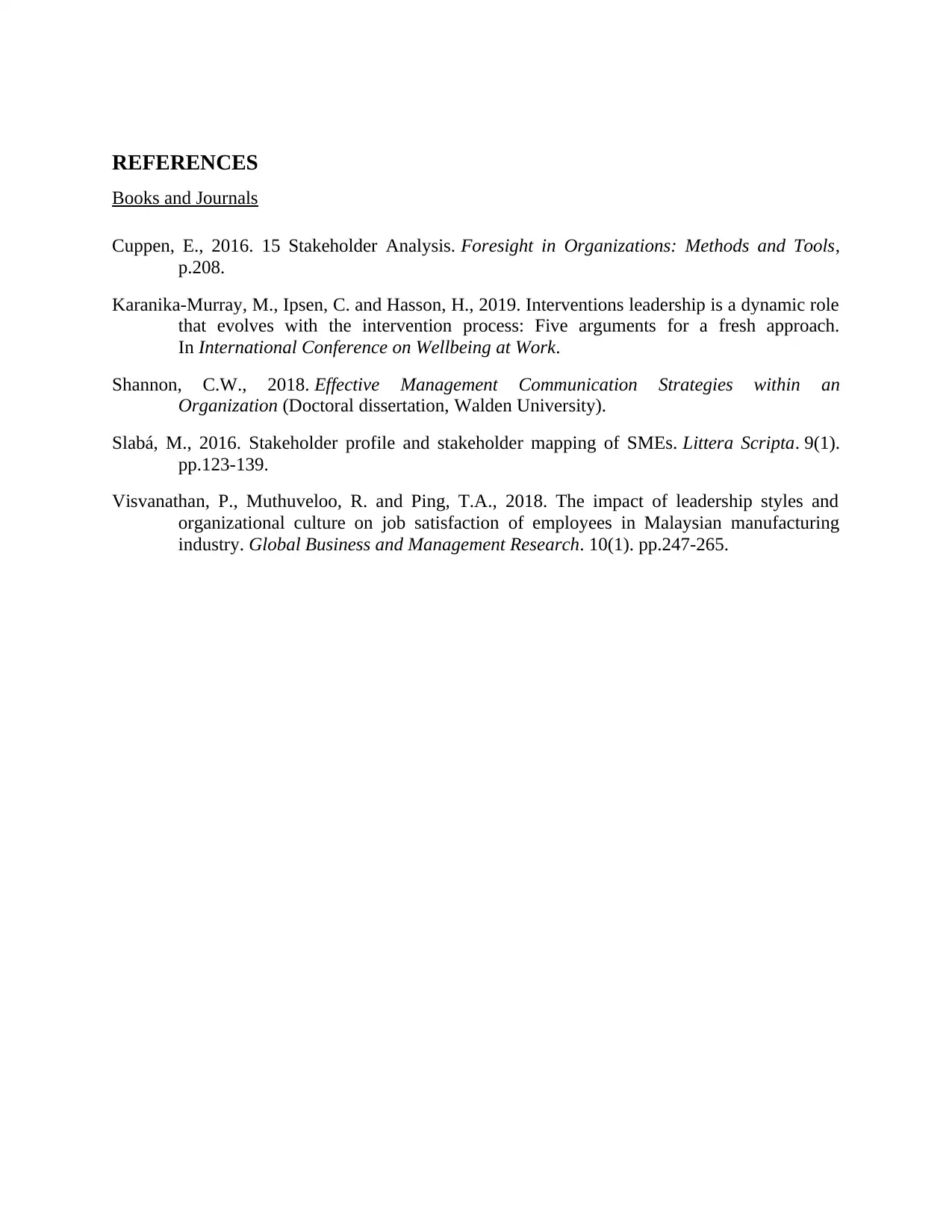
REFERENCES
Books and Journals
Cuppen, E., 2016. 15 Stakeholder Analysis. Foresight in Organizations: Methods and Tools,
p.208.
Karanika-Murray, M., Ipsen, C. and Hasson, H., 2019. Interventions leadership is a dynamic role
that evolves with the intervention process: Five arguments for a fresh approach.
In International Conference on Wellbeing at Work.
Shannon, C.W., 2018. Effective Management Communication Strategies within an
Organization (Doctoral dissertation, Walden University).
Slabá, M., 2016. Stakeholder profile and stakeholder mapping of SMEs. Littera Scripta. 9(1).
pp.123-139.
Visvanathan, P., Muthuveloo, R. and Ping, T.A., 2018. The impact of leadership styles and
organizational culture on job satisfaction of employees in Malaysian manufacturing
industry. Global Business and Management Research. 10(1). pp.247-265.
Books and Journals
Cuppen, E., 2016. 15 Stakeholder Analysis. Foresight in Organizations: Methods and Tools,
p.208.
Karanika-Murray, M., Ipsen, C. and Hasson, H., 2019. Interventions leadership is a dynamic role
that evolves with the intervention process: Five arguments for a fresh approach.
In International Conference on Wellbeing at Work.
Shannon, C.W., 2018. Effective Management Communication Strategies within an
Organization (Doctoral dissertation, Walden University).
Slabá, M., 2016. Stakeholder profile and stakeholder mapping of SMEs. Littera Scripta. 9(1).
pp.123-139.
Visvanathan, P., Muthuveloo, R. and Ping, T.A., 2018. The impact of leadership styles and
organizational culture on job satisfaction of employees in Malaysian manufacturing
industry. Global Business and Management Research. 10(1). pp.247-265.
1 out of 7
Related Documents
Your All-in-One AI-Powered Toolkit for Academic Success.
+13062052269
info@desklib.com
Available 24*7 on WhatsApp / Email
![[object Object]](/_next/static/media/star-bottom.7253800d.svg)
Unlock your academic potential
Copyright © 2020–2025 A2Z Services. All Rights Reserved. Developed and managed by ZUCOL.





